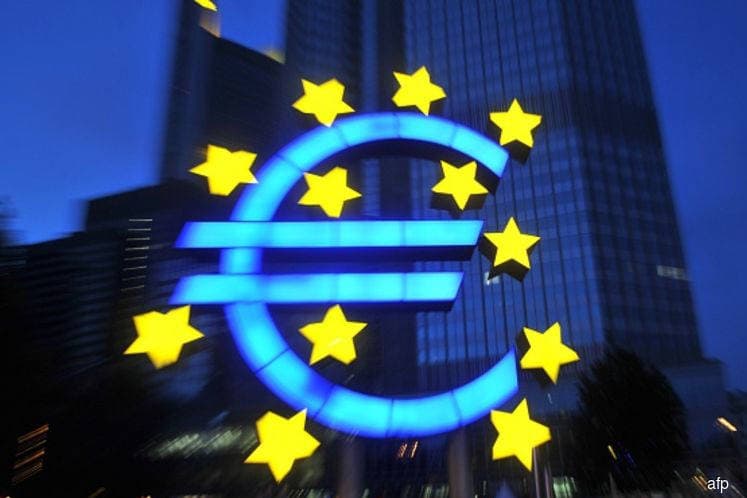
This article first appeared in The Edge Financial Daily on June 14, 2018
KUALA LUMPUR: The end of easy money is imminently close as the European Central Bank (ECB) meeting today is likely to involve discussions on concluding its quantitative easing (QE) programme, according to analysts monitoring policy decisions of the major central bankers.
By the time this article is published, the US’ Federal Open Market Committee (FOMC) may have decided on a 25 basis points (bps) rate hike. The outcomes of the ECB and Bank of Japan (BoJ) meeting are also expected to be known by this week.
“On the European front, ECB officials have hinted that the committee will discuss its exit plan from its QE programme during the upcoming meeting on Thursday (today). The ECB has embarked on normalising its easing programme since January 2018, reducing its monthly bond purchasing rate from €60 billion (RM282.26 billion) to €30 billion.
“Given evidence of economic recovery in the eurozone despite recent disappointment in data, it is inevitable that some of these easing measures have to be unwound. Besides that, the ECB is also faced with some constraints on the amount of bonds they are able to buy,” Maggie Wong, senior portfolio manager at Affin Hwang Asset Management told The Edge Financial Daily via email.She noted that yields for German bunds have been driven lower amid recent political uncertainty across the eurozone, as well as multiple data surprises on the downside.
“Any indication of QE taper will result in higher German bund yields, which may spill over to other rate markets as well. But the central bank has previously guided for rates to stay unchanged “well past” the programme’s conclusion, and any future moves will likely be more gradual and incremental in nature,” Wong said.
Similarly, UOB Malaysia economist Julia Goh said the ECB is likely to discuss the tapering of its bond purchases. “Generally, we will see some emerging market (EM) risk aversion and domestic policy uncertainty to weigh on the ringgit. Hence, we should be seeing the US dollar/ringgit inching higher,” Goh said.
The ringgit against the US dollar is flirting with the 4.0 level, which has not been breached since Jan 10 this year. At the time of writing, it was traded at 3.9938 against the US dollar.
Ray Choy, the head of treasury and markets research at CIMB Investment Bank Bhd, said initially, the expectation was for the ECB to end asset purchase in the third quarter this year, although the political situation in Italy as well as fears of the domino effect across the European Union may hamper this plan. If the ECB turns more dovish due to recent Italian developments or other reasons, this may support EMs since this reduces the worries of a synchronisation of tighter monetary policy on a global scale,” Choy said.
However, Jameel Ahmad, the global head of currency strategy and market research at FXTM, said EM currency fluctuations remain heavily reliant on the momentum of the US dollar, thus the US interest rate decision will likely have a greater impact on the ringgit than the outcomes of both the ECB and BoJ meetings. “The ECB and BoJ will still be seen as important event risks of course,” he said.
On the FOMC, Wong said the market has priced in a 25bps rate hike, which will bring the US benchmark rate to a new range of 1.75% to 2%. “The focal point this time around will be on the Fed’s (US Federal Reserve) gross domestic product (GDP) and inflation projections, whereby a higher forecast could spell an increased pace of monetary policy tightening,” she added.
While the Fed had guided for three hikes for 2018 during the FOMC meeting in March, analysts would look out for the Fed’s dot plot projection and whether they will raise the Fed funds rate forecast by 25bps as well as projections for 2019 and 2020, Wong said. “Given rising inflation on the back of higher energy prices, [the] market has now priced in a 40% probability of an additional hike in December 2018 (four hikes in total). We expect to see some upside pressure on yields on a hawkish outcome,” she noted.
CIMB’s Choy also said the market expects three to four rate hikes in 2018 and the trend is for the monetary tightening in the US to continue into 2019. “A common concern is for rate hikes to be damaging to the EM currencies, including the ringgit, although markets will vacillate between rate hikes and growth concerns caused by ongoing trade tensions between the US and the rest of the world. Nonetheless, the communications of these rate hikes were well in advance, which should not surprise investors, hence the impact could be muted,” he added.
As for portfolio positioning, Wong maintained a defensive stance and will hold on to higher cash levels for the interim. “As we head into the US Fed and ECB policy meetings this week, we will refrain from lengthening our portfolio duration at least until more clarity is seen,” she said.
Choy, on the other hand, expected the bond market to have priced in the rate hikes beforehand, and that the reaction by markets in EMs and Malaysia is likely to be minor. He noted that the US is already at the mature stage of the rate hike cycle.
As for Japan, Choy noted that the monetary policy will continue to be accommodative as its economy remains weak and inflation targets are being missed. “As such, Japanese money is likely to seek better returns overseas given low interest rates at home and this may mean a greater impetus for funds to flow from Japan to Malaysia and other high growth economies,” he added.